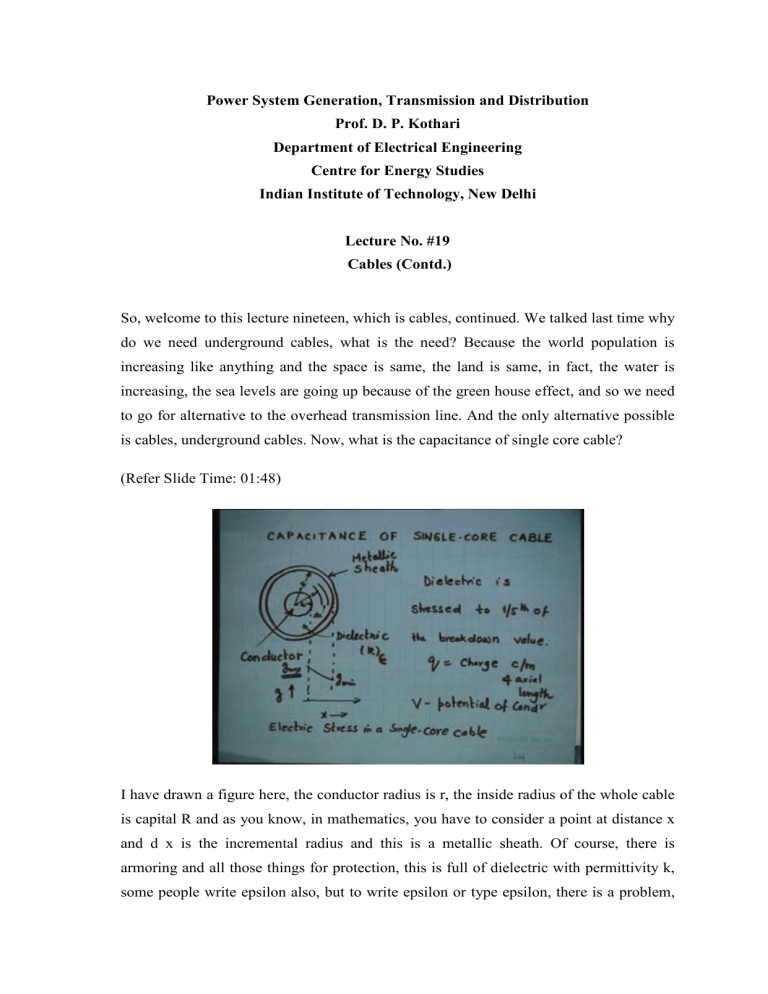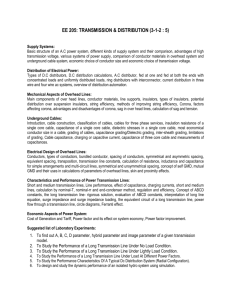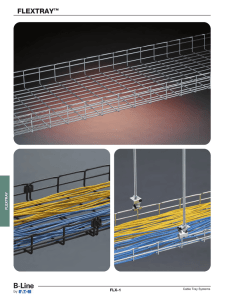
Power System Generation, Transmission and Distribution
Prof. D. P. Kothari
Department of Electrical Engineering
Centre for Energy Studies
Indian Institute of Technology, New Delhi
Lecture No. #19
Cables (Contd.)
So, welcome to this lecture nineteen, which is cables, continued. We talked last time why do we need underground cables, what is the need? Because the world population is increasing like anything and the space is same, the land is same, in fact, the water is increasing, the sea levels are going up because of the green house effect, and so we need to go for alternative to the overhead transmission line. And the only alternative possible is cables, underground cables. Now, what is the capacitance of single core cable?
(Refer Slide Time: 01:48)
I have drawn a figure here, the conductor radius is r, the inside radius of the whole cable is capital R and as you know, in mathematics, you have to consider a point at distance x and d x is the incremental radius and this is a metallic sheath. Of course, there is armoring and all those things for protection, this is full of dielectric with permittivity k, some people write epsilon also, but to write epsilon or type epsilon, there is a problem,
so I have preferred using k of course. Similar, good luck is not available to permeability where we use only mu, there is no alternative to mu here; there is an alternative to epsilon.
Now, if you plot the electric stress in a single core cable, unfortunately it is not uniform, it varies as you move from conductor radius to the inner radius of the cable and it is maximum at the conductor radius or at the surface of the conductor, and it is g max. And as you go towards the outer part of the cable through dielectric, it reduces and finally, you get g min; that means, dielectric is stressed to the 1-5th of the breakdown value.
Because you have to worry about g min, sorry, g max and g min is very small, q is the charge in Coulombs per meter of axial length, V is a potential of conductor. Those of you have done field theory, all these things should be very easy for you, in any case you must have done cables earlier.
(Refer Slide Time: 04:16)
Now, as I said, g was defined as electric field intensity gradient. And you know, the quotient g is equal to q upon 2 pi k x; x is the radial distance to a point from the centre of the conductor; q is the charge we have just now defined; k also I told you, and gradient is always given by voltage per meter. Now, if you want V, it will be integral of r to R g d x, substitute the value of g and you get the answer log R by r when you substitute the limits, lower limit; this integrals you must have done 100 times or 1000 times in past so many years. A capacitance between core and sheath is given by C q by v, those things you can
substitute, I am just directly giving the results, 2 pi k 0 k r; k 0 is the permittivity of the free space, that is, 8.5 into 10 is to power minus 12 Farads per meter; k r is relative permittivity, this R, this is Farads per meter, you substitute, this g is also equal to, if you manipulate here, you will get V x ln by R by r, the only variable is x. So, if you want g max, the minimum value of x is R, so you get g max. If you want max value r, if you want minimum, then capital R and the ratio of g max by g min is naturally R by r. Now, this should be as close to 1 as possible, and for that what we do, anybody remembers or all of you have forgotten? We need grading, grading of cables. So, grading of cables is of course, an important topic, I do not want to do it because you have already done it, my aim is only to refresh your memory and not go in more details.
(Refer Slide Time: 06:33)
Now, R is fixed, capital R, because the total dimension of cable is fixed, what you do inside is your problem. For example, the government has fixed your fellowship, may be
5000, may be 6000, may be 8000, may be 10000, depending on which fellowship you are getting, is it MNES, is it high-value fellowship, is it government of India or whatever, is it CSIR, but how do you spend, I do not think anybody has any right to tell you what you should do with your fellowship, it is up to you. Whatever the minimum base load, as I call it, scholarship, sorry, the fees, mess dues, electricity, water, books, copies and then whatever is remaining, it is up to you, whether you send home, which is very rare and small percentage, all whatever you can do. So, similarly, that R can be adjusted, what
should be small r, etcetera, etcetera, that is up to you and that is a job of a designer, power system designer.
For a given voltage is always fixed and this inverse E is there exist, this must have been told by your mathematics teacher, for a given V there exist a small r, which minimizes g max. So, this is the condition for design of a cable because we do not want to stress it to any higher degree to avoid any possible reason for breakdown, that is, we want to maximize this quantity. Why you want to maximize this quantity, because if you want to minimize g max, we had to maximize the denominator, so that g max will be min. So, it is a min max problem optimization technique, you are minimizing the maximum value of g, so this should be maximum. If you carry out this maximization problem, naturally the only variable is r, so d by d r of the this, you put it equal to 0, solve it, the answer is this.
That means, R by r is should be e, any natural logarithm of something is 1 means that something is e and this is 2.71882. So, as we move, towards, away from conductor, it is understressed, that is what we have been talking for last 5 minutes, that g max to g min.
Therefore, more uniform stress distribution is required; otherwise you are not using the gradient. The insulation, the dielectric to full extent, it is like hiring 1 hour cab for 1 hour and using only for 2 minutes, you are unnecessarily paying. Across the dielectric, to minimize, minimum amount of insulation required for a given r v and this is the topic of grading of cables.
(Refer Slide Time: 10:18)
So, grading of cables is the difference between g max and g min should be minimized you cannot make it 0. There are so many things, which you cannot make 0, you cannot make your expenses 0, you cannot make your profits or fellowship or whatever, infinity that is impossible, that is only theoretical, so, so that less insulation or dielectric is required, so that I pay less money, ultimately everything boils down on to cost.
So, capacitance, there are only 2 types of grading in literature, capacitive grading and intersheath grading, which you must have learned in your undergraduate. Intersheath is better than capacitance grading. What is the power factor in heating in cables?
The best books for reading cables is , I already told you and old timers can read or . is not an old timer, he is still alive and his books are still coming; classic, when I say
Loney, that is a classic, the book which went for a century and more. So, books my teachers have also read and is the latest edition. Wadhwa has given a chapter of course on cables, we are, that way Soni, Gupta and Bhatnagar has also given, Mehta has also given and so many books are there, I do not, I really gives anything on cables even isn’t giving anything, we have only given few pages as an appendix in that brown book only.
Now, this is the equation for resistance, rho 2 pi l log of R by r ohms, rho is resistivity, everybody knows, and capacitance, capacitive current supply is omega C V; C is the cable capacitance.
(Refer Slide Time: 12:43)
If you plot a Faser diagram, you will find, that the charging current is leading voltage almost by 90 degrees though the figure does not show that effect, but practically speaking, phi is almost 90 degree and delta is very small, phi is 90 degrees, where cosine phi is a cable power factor, cosine phi is also equal to cosine pi by 2 delta, that is trigonometry, you must have done in your 9th class or 8th class, I do not know. So, cosine of pi by 2 minus something is sine of same angle, that everybody knows, angle delta is so small, the sine of small angle is angle itself and this is also tangent. So, power factor is delta and V by R by R, V by R i rho omega C V or 1 over omega CR i, V, V gets cancelled, this is a power factor for a cable.
Dielectric loss is a very important loss in cables. Breakdown of a cable can cause or can be caused due to thermal reasons. What these losses, why we do not like any loss?
Because not only that your efficiency goes down, but it creates or generates or produces, whichever word you want to use, heat. Anything that produces heat is bad, whether it is an argument, whether it is a Parliament, whether it is electrical engineering or mechanical engineering, but heat, you cannot avoid. So, losses generate heat, so temperature rise takes place and temperature rise, I have been telling you, MATR, maximum allowable temperature rise, if you go beyond that, there may be blood pressure problem, there may be even heart attack, so we do not want to break any hearts. So, or they can be mechanical causes or there can be electrical causes.
(Refer Slide Time: 15:20)
What are different losses, these are all the 3 things, which can be asked in interviews, you should know about this: core loss, dielectric loss, sheath loss. Fortunately, sheath loss is very small; dielectric loss we have just talked about, it is caused by dielectric absorption or polarization and it is very small, up to 33 kv. What is an equivalent circuit of cable? It is a leakage resistance in parallel with cable capacitance; this is an equivalent circuit for a cable. And please remember, there is no pi network here, there is no t network here, nothing is here, there is only 1 network and it is in parallel. Now, the circuit is so small, that whether it is in parallel or series it hardly matters, but since the book says it is in parallel, let us also say it is in parallel. So, some of you are capable of arguing, sir how it is in parallel, to me it looks series. So, dielectric loss is a loss in the equivalent leakage R, this R is like a transformer, you must have done an equivalent circuit of a transformer, 6 parameters: primary, secondary and the magnetizing branch, which is in the middle, but taken into one end for simplification, every person in the world wants simplification, easy life. So, to make our life easy, they have shifted that middle branch to one end. Now, dielectric loss is V I cosine delta E I cosine phi, sorry, sine phi and this is, this equal to E I delta, also I is equal to V omega C. So, dielectric loss is V square omega C delta. If you want to expand omega into 2 pi f, this is the equation for dielectric loss. Those of you join a cable company like or like, there is one in Faridabad, Hindustan cable company, so there you will need this knowledge more.
(Refer Slide Time: 17:39)
33 kv, the rated current 1 percent and 400 kv, it is 15 percent, sheath loss is roughly 0, 2 percent of the core loss. Now, ionization is another process, which takes place and it creates problem and this question is almost always asked in cable void formation, why they takes place and how do you avoid it? Yes, the effect is a chemical reaction resulting in a gradual breakdown of the dielectric. Now, it can be even a manufacturing fault. Do not think, that you all created void while manufacturing and if it is in India, people are careless, may be voids have been formed. But even if manufacturing is perfect, it is made in England or made in US, void can still be formed while in use because of contraction and expansion. Chief cause of deterioration of a cable is dielectric and dielectric is a must. Now, DC, everything we are now going DC except generation. In fact, solar is again a DC, MSD is again a DC, so I should not say that generation is also only AC, there is a DC generation as well, may not be in bulk, but we are again moving towards disperse system from the vertical interior type power system disperse and distributed system now you can read more about it in our new book also there is a if you have seen that we have already a copy to library you can read the 1st chapter it is very useful for interviews.
So, DC cables also are there, it is not a fiction, it is reality and they are available up to plus minus 600 kv, losses are definitely less than AC. Whenever you are asked, what are the advantage of anything DC over AC? There is no screen effect, dielectric losses are also small; sheath losses are smaller. And what is cross-bonded cable, anybody? I am going to test your knowledge; anybody remembers, what is a cross-bonded cable? People have done PhD’s on cross-bonded cable, one of the student is with me, Pramod Kumar, see his thesis in electrical department library, department library. Cross-bonded cable is like your transportation, corresponding thing in transmission, line overhead transmission line is transposition, so here it is cross-bonded. I think, with this, we will finish the cable topic today and Tuesday we will start insulators.
Now, what are insulators? Why you should have insulators? Because the transmission line wires are live, so on poles or on towers, depending on the kv, the voltage, we have the insulators and there are mainly 3 types of insulators: pin type, strain type and suspension type. It is mainly suspension, which is used and the strain type is used for a special purpose. Wherever there is a change in direction, wherever there is a dead end,
wherever there is a river, wherever there is a crossing, so we use the same suspension in, instead of vertical we make it horizontal and that is called a strain type insulator.
Now, the pin type is of course, they are upto 33 kv, but beyond we go for suspension type and that is modular in approach. The higher the voltage, more can be added and again, there is a problem of uniform distribution of voltage there. So, if you want to avoid that problem, what you do? You can make the cross-arm length long, but then it looks very ugly and the 1st thing varies, the space. We are always worried about space right of way, so that option is ruled out in the present day world. So, we go for a different option and we will talk about it, that is called grading of insulators again, like grading of cables and there is a guard ring used or there are, you know, different types of can be used, but they are not practical. Because again, the line insulator, that is, insulator closest to the conductor is stressed maximum and others are, as you go progressively towards, because of their stress less, we will see all those things of course, we have done it.
So, I will not take much of our time in insulators, but small amount of insulators. Then, I intend to do sag and tension again in one lecture or, and tension you are not done, so we will do it, so that those of you have not done it, they should know. Yeah, that is very important and then we will go for insulation and not…, insulation load flow is next, next semester, then we will go for AGC, we go for HVDC and distribution facts, if time permits why not, but we have roughly 1 month left. So, we stop today.



